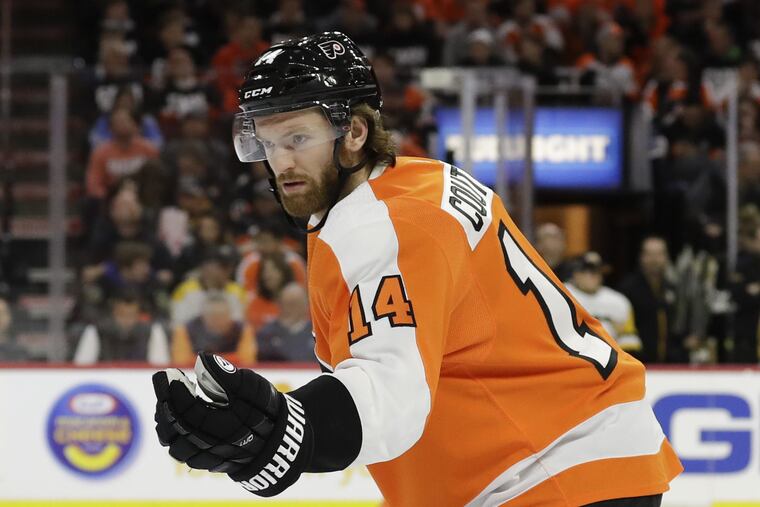They call Flyers center Sean Couturier ‘Godfather,’ and he’s his dad’s boss | Marcus Hayes
The Flyers center participated recently in a Q&A.

To hear him speak, you'd never guess that Sean Couturier is a son of the desert (he's really not). To watch him play his first seven seasons, you'd never know "Coots," as his Flyers teammates call him, could be an offensive force. To witness his ferocity as a long-haired, physical centerman, you'd probably not figure him to be a cat guy, but he has two (and a dog).
He landed with the Flyers in 2011, the eighth overall selection in the National Hockey League draft made with a pick they acquired in an offseason trade with Columbus that also made Jake Voracek a Flyer. At 6-foot-3, with a big frame that has filled out to 211 pounds now that he's 25, Couturier made the team just months after he was drafted and was immediately so solid defensively that he was tasked with muzzling Pittsburgh Penguins star Yvgeni Malkin in the playoffs that year, even as he continued his slow recovery from mononucleosis. Now an alternate captain, he has ascended to the Flyers' first line and — with all respect due Claude Giroux and Voracek — Couturier is their most indispensable player.
Marcus Hayes chatted with Couturier last week about all of this, and about being his dad's boss … and being The Godfather.
You were born in Phoenix, where your dad, Sylvain, was in the midst of a career spent mostly in the minors, but you moved to New Brunswick (Canada) as a young boy and grew up in a little city called Bathurst, where your father is still the general manager of the local junior team, the Acadie-Bathurst Titan. You were part of a group that bought the club in 2013, and the arena sits on Sean Couturier Avenue. Is it weird to be your dad's boss? More importantly: Is he on the hot seat?
He's not on the hot-seat this year. They won the Memorial Cup [the Quebec Major Junior Hockey League (QMJHL) championship] last year, so he's safe for a little while. It's a great honor to have the street named after me. I'm proud of where I'm from. I try to be a role model for kids and people from Bathurst. My fiancee is from Drummondville, where I played junior hockey and still train. I get back to Bathurst to visit my parents once or twice a summer. I'll go during their training camp, which is just before this training camp. Get some good practices in. Then come here afterward.
You've had your share of injuries over the years, but you came into the league especially well-equipped to deal with hindrances. What were you dealing with your last year in juniors (2010-11), when you won the league QMJHL MVP award? Did it linger into your rookie year with the Flyers, which ended with you making your name against Malkin, the NHL MVP that year?
I had mono that summer (2010). I'm not going to lie. It was pretty hard for a year or two. I could play and stuff, but I never felt I was 100 percent energy-wise. I always felt a little fatigued. I was always sleeping. Taking two- or three-hour naps every day. Trying to get through it. The first year was really tough. Then, when I got here, there was a lot of stress, a lot of expectations.
The Malkin matchup gained you a reputation as an elite defensive player. You were a Selke Trophy nomination last season (the Kings' Anzi Kopitar won), the first Flyer since Mike Richards was nominated in 2009. You scored 31 goals last season and were a plus-34. Do you mind the reputation? Is winning the Selke like being the mediocre quarterback who throws the fewest interceptions?
I think the criteria has changed over the years. It's not just a defensive-forward prize any more. It's more like you've got to be solid defensively, and you've got to put up numbers, too. You've got to be all-around. The best two-way forward would better describe it.
So, did you set out the be the lock-down guy?
I had no choice, really. My first year here we were pretty stacked at forward. [Jaromir] Jagr signed that summer. Simmer [Wayne Simmonds] and Jake [came] in big trades. The only way I could play was to take that defensive shut-down role. I embraced it as much as I could,and had a lot of success with it. In juniors, I learned how to be a good two-way forward. You want to be out there when you're leading, 2-1, or you're down a goal. You want to be out there for that big face-off. I think people saw me as only that afterward, that I could only be that defensive guy because I took so much pride in it. But I knew I could produce offensively and be a solid two-way player. Glad I got the opportunity to show it.
Voracek and Simmonds had 49 points apiece that season, 22 more than you, and got more attention that season, when you were 19. They were more established, but Jake was only 22 and Simmonds just 23. As the three new guys, did you form a special bond?
Oh yeah. We're close on and off the ice. We're very similar. We're close enough that Jake named me godfather of his son (Jake Jr., 23 months). We like being around the guys, and we'd do anything for the team.